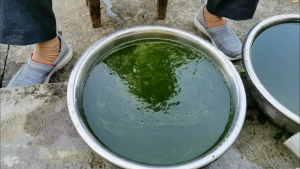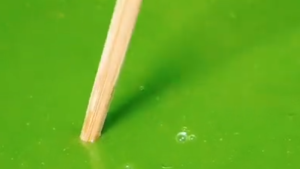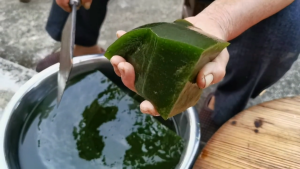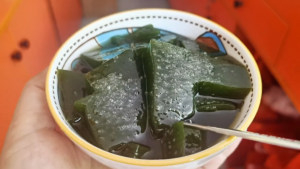Using just a handful of leaves and some ash, one can make tofu resembling emerald, known as Guanyin Tofu or Divine Tofu. Some also refer to it as Jade Tofu due to its jade-like color, crystal-clear appearance, smooth and delicate texture, and refreshing taste. It’s known for its heat-clearing, detoxifying properties, with a subtle fragrance of fresh grass and wood. It’s a natural jelly, delicious when mixed with sugar. For those with acne or sores, consuming it can lead to improvement. It also aids in relieving itching, promoting blood circulation, reducing swelling, diuresis, and nourishing the skin.
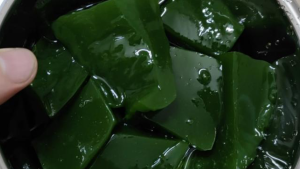
The leaves used in making Guanyin Tofu are called Guanyin leaves, also known as Guanyin firewood or Guanyin hawthorn, with the scientific name of Celtis biondii. Other scientific names include tofu firewood and rotten slave. The leaves serve as the main ingredient in making Guanyin Tofu. The plant itself is referred to as the Guanyin tree or Divine tree, belonging to the family Cannabaceae. It’s a shrub with rich pectin content in its leaves, emitting a faint fragrance and offering rich nutrition. It bears small yellow flowers and has a faint purple hue at the base of its leaves. Typically, it grows during the summer. When young, its branches have tiny hairs, which shed as they mature. It flowers and bears fruit from May to October, with small umbrella-shaped yellow flowers followed by purple berries. The berries are sweet and can be used to make beverages or wine. The leaves are oval-shaped with high pectin content, making them ideal for making tofu. The pectin is extracted to produce Divine Tofu. In industrial applications, it’s used in making soft candies, jellies, and as a gelling agent. The entire plant is medicinal and can be used to treat bleeding wounds, digestive issues, and inflammation. It’s also effective in regulating blood sugar, lipid levels, and blood pressure, making it a valuable dual-purpose plant.
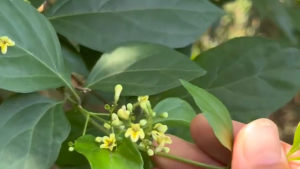
The leaves come in two types: large and small. Many are familiar with the large leaves, but the small ones have a red stem and fine white hairs on the branches. To distinguish the Guanyin tree and its leaves, one can rely on their fragrance, flower characteristics during flowering seasons, distinct leaf veins, soft leaf texture, and net-like branches.
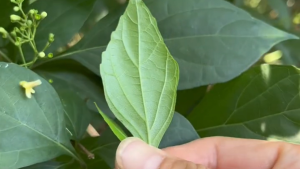
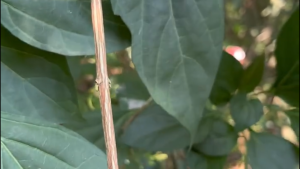
Legend has it that long ago, Guanyin Bodhisattva sprinkled nectar from willow branches, causing Guanyin trees to grow on the mountain. The divine beings appeared in dreams, revealing that food made by mixing the leaves with ash could alleviate famine. Hence, people started calling this type of tofu Guanyin Tofu.
How do these small leaves turn into blocks of emerald tofu? Let’s take a look at the production process.
1. Picking Leaves: Gather fresh Guanyin tree leaves. When picking, simply pluck the leaves without damaging the tree.
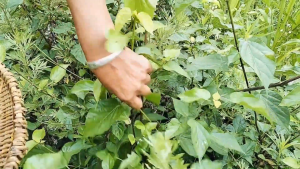
2. Washing Leaves: Clean the leaves thoroughly by washing them several times. It’s best to blanch the leaves in hot water first, then rinse them in cold water. Stir them to ensure even heating, removing any bitterness. Blanching for about a minute is sufficient; prolonged exposure may cause discoloration.
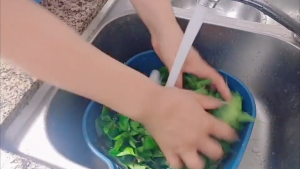
3. Rubbing Leaves: The ratio of leaves to water can vary between 1:5 to 1:10, with a common ratio being 1:8. Alternatively, concentrated juice can be used. In a basin, ensure the water level does not exceed that of the leaves. Typically, the concentration of the juice is judged by experience. Gradually add water during rubbing, using your hands to squeeze out the juice. There’s a difference between using a juicer and hand-rubbing. Rub until a thick, viscous juice is obtained. The longer you rub, the thicker the juice becomes, making it harder to extract from the leaves. Assess the amount of juice extracted from the leaves; if it’s abundant, you can continue with a fresh batch of water. The juice should be smooth and exceptionally viscous, with a fragrant aroma and a vividly translucent green color. Through repeated rubbing, extract the plant’s gelatinous substance. The juice may become somewhat sticky and thick, indicating successful extraction. Remove any foam on the surface; this ensures proper solidification after adding the alkaline solution later.
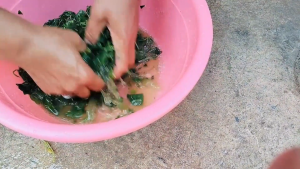
4. Filtering the Juice: Strain the squeezed juice using cheesecloth, separating the extracted juice from the residue. Filter out the residue, retaining only the thick, viscous liquid. Pour the liquid through the cheesecloth filter, ensuring that the main components are the cohesive liquid without fine leaf debris. Filter until the liquid is clear, then use your hands to press and squeeze out any remaining liquid. This method quickly achieves thorough filtration. Remove any foam from the surface, ensuring the filtered juice remains free from residue. Avoid allowing any residue to remain, as it may hinder the tofu’s formation and cause it to disperse. Skillful filtration preserves the pure taste and nutritional value of the Guanyin tofu.
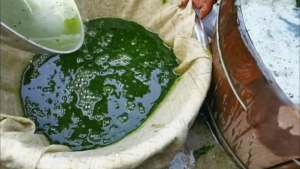
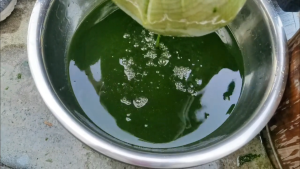
5. Making Wood Ash Solution: Wood ash is used as a coagulant, containing potassium ions that form lenticular jelly. The solution primarily consists of potassium carbonate and calcium carbonate, both alkaline. Alternatively, calcium tablets can also serve as a coagulant, primarily composed of calcium carbonate, also known as limestone, which is alkaline in chemistry. Wood ash serves as a disinfectant and preservative. In rural areas, using wood ash in rice dumplings can keep them fresh for up to half a month. Wood ash is readily available from burning firewood in rural settings. White ash is preferred. The ratio of wood ash to water can range from 1:5 to 1:10. Soak the wood ash in clean water, stirring to ensure even distribution. Filter the wood ash solution through cheesecloth to remove any residue. It’s crucial to filter the wood ash solution 2 to 3 times to avoid a gritty texture in the tofu, which could affect its taste. Using wood ash from a wood fire is essential for quick solidification. Traditional methods yield a more authentic taste. Tofu made with wood ash is exceptionally delicate and smooth, while that made with calcium tablets tends to be slightly firmer. Set aside the filtered wood ash solution for later use.
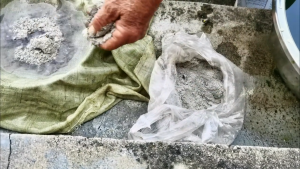
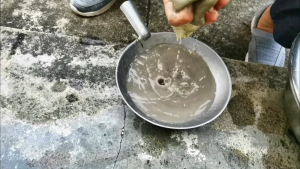
6. Adding Alkaline Solution, Commonly Known as “Pointing Broth”: A critical step in making Guanyin Tofu is “pointing broth.” The wood ash-filtered water is added to the Guanyin tree leaf juice. The recommended ratio of wood ash water to Guanyin leaf juice is 1:10. Add the alkaline solution gradually to the juice, stirring vigorously in the same direction each time. Allow any sediment from the wood ash water to settle at the bottom of the bowl; do not include it. During stirring, if you feel resistance, it indicates the tofu is halfway successful. Skim off any foam and continue stirring evenly for half an hour until it solidifies.
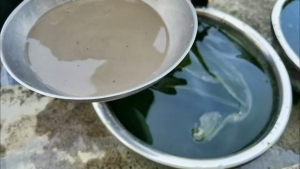
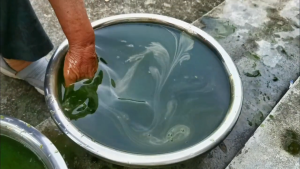
7. Setting and Shaping: Allow the thickened juice to settle for a period to solidify. Approximately 20 minutes of settling is sufficient; it should be firm enough to stand a chopstick upright. Once solidified, cut it into large pieces first, then into smaller cubes. Serve with your preferred sauce or seasoning. You can cut it into any shape you desire, and flavors can be customized as per your preference. It pairs well with sugar, sour and spicy sauce, or milk. Some even enjoy it raw. Suitable for both the elderly and children, it’s appetizing and delicious with a delightful fragrance.
